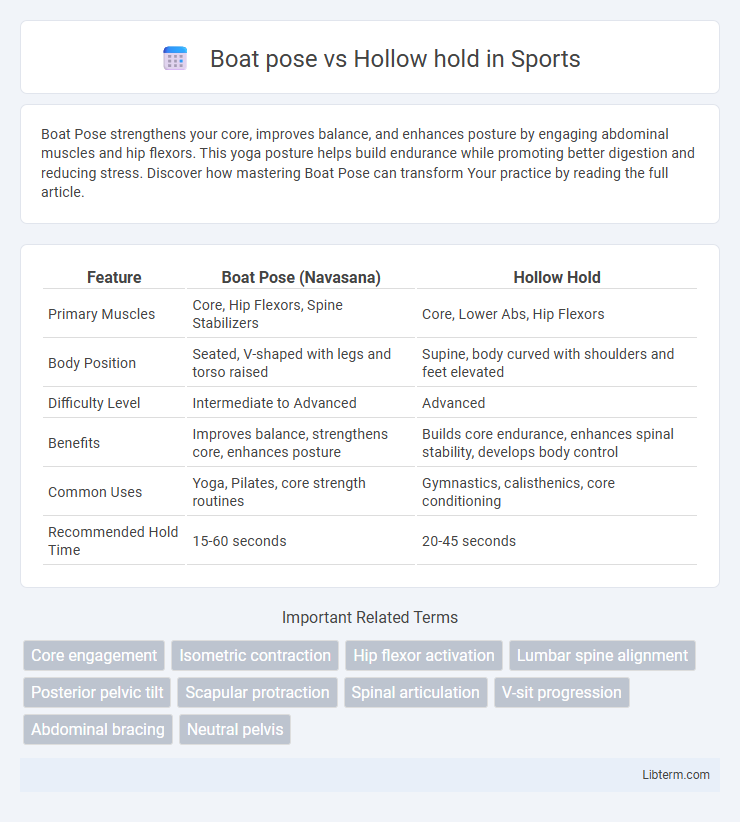Boat Pose strengthens your core, improves balance, and enhances posture by engaging abdominal muscles and hip flexors. This yoga posture helps build endurance while promoting better digestion and reducing stress. Discover how mastering Boat Pose can transform Your practice by reading the full article.
Table of Comparison
| Feature | Boat Pose (Navasana) | Hollow Hold |
|---|---|---|
| Primary Muscles | Core, Hip Flexors, Spine Stabilizers | Core, Lower Abs, Hip Flexors |
| Body Position | Seated, V-shaped with legs and torso raised | Supine, body curved with shoulders and feet elevated |
| Difficulty Level | Intermediate to Advanced | Advanced |
| Benefits | Improves balance, strengthens core, enhances posture | Builds core endurance, enhances spinal stability, develops body control |
| Common Uses | Yoga, Pilates, core strength routines | Gymnastics, calisthenics, core conditioning |
| Recommended Hold Time | 15-60 seconds | 20-45 seconds |
Introduction to Boat Pose and Hollow Hold
Boat Pose strengthens the core by engaging the abdominal muscles, hip flexors, and spine stabilizers while balancing on the sit bones, making it a fundamental yoga posture for improving posture and balance. Hollow Hold targets the deep core muscles, including the transverse abdominis and rectus abdominis, by requiring a hollowed-out torso position with legs extended and shoulders lifted off the ground, enhancing core endurance for athletes and gymnasts. Both exercises develop core strength but emphasize different muscle activation patterns and body awareness techniques.
Differences in Form and Technique
Boat pose engages the core by balancing on the sitting bones with legs lifted and extended, arms reaching forward parallel to the ground, emphasizing spinal length and chest elevation. Hollow hold requires lying on the back with lower back pressed into the floor, legs extended and lifted slightly off the ground, arms overhead or alongside ears, focusing on abdominal tension and minimizing arch in the lumbar spine. The primary difference lies in Boat pose's seated, upright balance demanding hip flexor activation, while Hollow hold emphasizes static abdominal compression with a flattened lower back.
Targeted Muscle Groups
Boat pose primarily targets the rectus abdominis, hip flexors, and spinal erectors, engaging the core and improving balance and stability. The Hollow hold emphasizes the rectus abdominis and transverse abdominis, creating a strong isometric contraction that enhances core endurance and abdominal compression. Both exercises strengthen the core but differ as Boat pose also involves the hip flexors and spinal stabilizers while the Hollow hold focuses on sustained core tension.
Core Strength Benefits
Boat pose targets the deep abdominal muscles, improving core stability and balance by engaging the hip flexors and lower back simultaneously. Hollow hold emphasizes isometric contraction of the entire core, enhancing muscular endurance and spinal alignment through sustained tension. Both exercises develop core strength effectively but vary in muscle activation patterns and functional benefits.
Flexibility and Mobility Demands
Boat pose demands significant hip flexor and spinal mobility to maintain a balanced V-shaped posture, enhancing core strength while requiring flexibility in the hamstrings and lower back. Hollow hold emphasizes shoulder stability and core engagement with minimal hip mobility needs, focusing on maintaining a tight, convex body shape that challenges abdominal endurance. Comparing both, boat pose necessitates greater flexibility and dynamic mobility, whereas hollow hold centers on static control and core strength without extensive mobility requirements.
Progression and Difficulty Levels
Boat pose engages the core by balancing on the sit bones with legs lifted, creating a mild to moderate challenge suitable for beginners progressing to intermediate levels. Hollow hold demands maintaining a flattened lower back against the floor while extending arms and legs, offering a higher intensity core contraction that typically serves intermediate to advanced practitioners. Progression from Boat pose to Hollow hold involves increasing core engagement and endurance, with the latter requiring greater muscular control and stabilization to maintain the extended position without losing form.
Common Mistakes and Corrections
Common mistakes in both Boat pose and Hollow hold include arching the lower back excessively and letting the shoulders slump forward, which can reduce core engagement and increase strain. To correct these errors, ensure the pelvis is tilted posteriorly to maintain a neutral spine and actively draw the navel toward the spine while keeping the chest lifted. Consistent scapular retraction and maintaining tension throughout the entire core are crucial for maximizing the effectiveness of both exercises and preventing injury.
Incorporating Each Into Your Routine
Incorporating Boat Pose (Navasana) into your routine enhances core stability and improves balance by engaging the abdominals, hip flexors, and spine muscles. Hollow Hold targets the deep core by maintaining a tucked position, strengthening your transverse abdominis and improving overall body control. Alternate between these exercises to build both dynamic and static core strength, optimizing functional fitness and endurance.
Suitability for Different Fitness Goals
Boat pose primarily targets core stability, balance, and hip flexor strength, making it ideal for improving posture and enhancing Pilates or yoga routines. Hollow hold emphasizes intense abdominal engagement and endurance, which benefits athletes focused on building a strong, resilient midsection for gymnastics or calisthenics. Both exercises can be adapted for various fitness levels, but choosing between them depends on whether the goal is overall core control or maximum core activation and endurance.
Choosing Between Boat Pose and Hollow Hold
Choosing between Boat Pose and Hollow Hold depends on your fitness goals and body awareness. Boat Pose, a yoga balance posture, emphasizes core strength and stability while promoting flexibility and mindfulness. Hollow Hold, a gymnastic conditioning exercise, targets deep core activation and endurance, making it ideal for athletes seeking to enhance overall core power and control.
Boat pose Infographic

 libterm.com
libterm.com